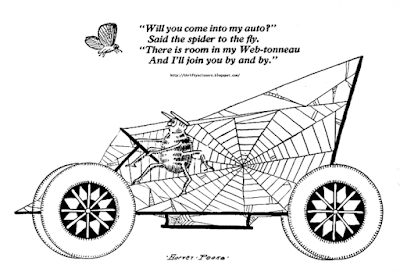Thursday, November 17, 2022
A Canine Sheep Stealer
Friday, December 10, 2021
If You're Good
IF YOU'RE GOOD
Santa Claus will come to-night,
If you're good,
And do what you know is right,
As you should.
Down the chimney he will creep,
Bringing you a woolly sheep,
And a doll that goes to sleep,
If you're good.
Santa Claus will drive his sleigh
Through the wood,
But he'll come around this way,
If you're good,
With a wind-up bird that sings,
And a puzzle made of rings;
He will bring you cars that go,
If you're good
Jumping-jacks and funny things,
If you're good,
And a rocking-horse, Oh, oh!
If you're good.
And a dolly that can sneeze;
That says "Mamma!" when you squeeze;
He'll bring you one of these,
If you're good.
Santa grieves when you are bad.
As he should;
But it makes him very glad
When you're good;
He is wise and he's a dear;
Just do right and never fear;
He'll remember you each year,
If you're good.
Thursday, November 29, 2018
Wednesday, March 14, 2018
Mother Goose Auto Parade - mini book
 |
| Paper mini book by Harvey Peake, restored by kathy grimm. Front Cover |
 |
| A frog he would a-wooing go In a very stylish way, So he bought a frogmobile, you know, And the lady frog said "Yea!" |
 |
| Jack be nimble! Jack be quick! Jack, jump over the candlestick! Jack jumped when something struck his wheel, For his candlestick was an automo- bile! |
 |
| The Man in the Moon, Come down too soon, And asked his way to Norwich. In his crescent machine, Made of cheese so green, He drove off after his porridge. |
 |
| Little Bo Peep had lost her sheep, And didn't know where to find them; But she turned them all to automobiles, And now she rides behind them. |
 |
| "Will you come into my auto?" Said the spider to the fly. "There is room in my Web-tonneau And I'll join you by and by." |
 |
| There was an old woman Who lived in a shoe, She had so many children She didn't know what to do. But she mounted the shoe On a big motor car, And now there is room For them all without jar. |
 |
| Peter, Peter, pumpkin eater, Had a wife and couldn't keep her; He made a car of the pumpkin shess, And there he kept her very well. |
 |
| There was an old woman lived under a hill On auto'bile wheels that wouldn't stand still. So she drove around selling her cranberry pies,- And she's the old woman who never told lies. |
 |
| "Mary, Mary, quite contrary, How does your garden grow?'' "Oh, now that I have a car," she said, "It grows twice as fast, you know." |
Friday, March 2, 2018
Mary Had A Little Lamb
Friday, September 20, 2013
"The Sheep And The Pig" by Aesop
Moral of the story: It is easy to be brave when there is no danger.
Thursday, March 21, 2013
Paper Patterns by Paul Konewka
 |
| A self portrait of Paul Konewka. |
Related Content:





